Types of Bits
In order to select the right bit, it is important to first understand the principles of how a bit functions and the pressure points on the horse that are affected by different bit types and designs. The two basic types of bits are snaffle bits and leverage (curb) bits. These differ in the areas on the horse where each applies pressure. In addition to these two types of bits, there are hackamores, which generally do not have a mouthpiece. Hackamores may either be true hackamores (bosal or sidepulls), which are direct pull devices, or mechanical hackamores, which employ leverage. There are also many pieces of headgear that combine a mouthpiece with a mechanical hackamore as well as several options that combine a snaffle bit with a piece over the nose that does not incorporate leverage.
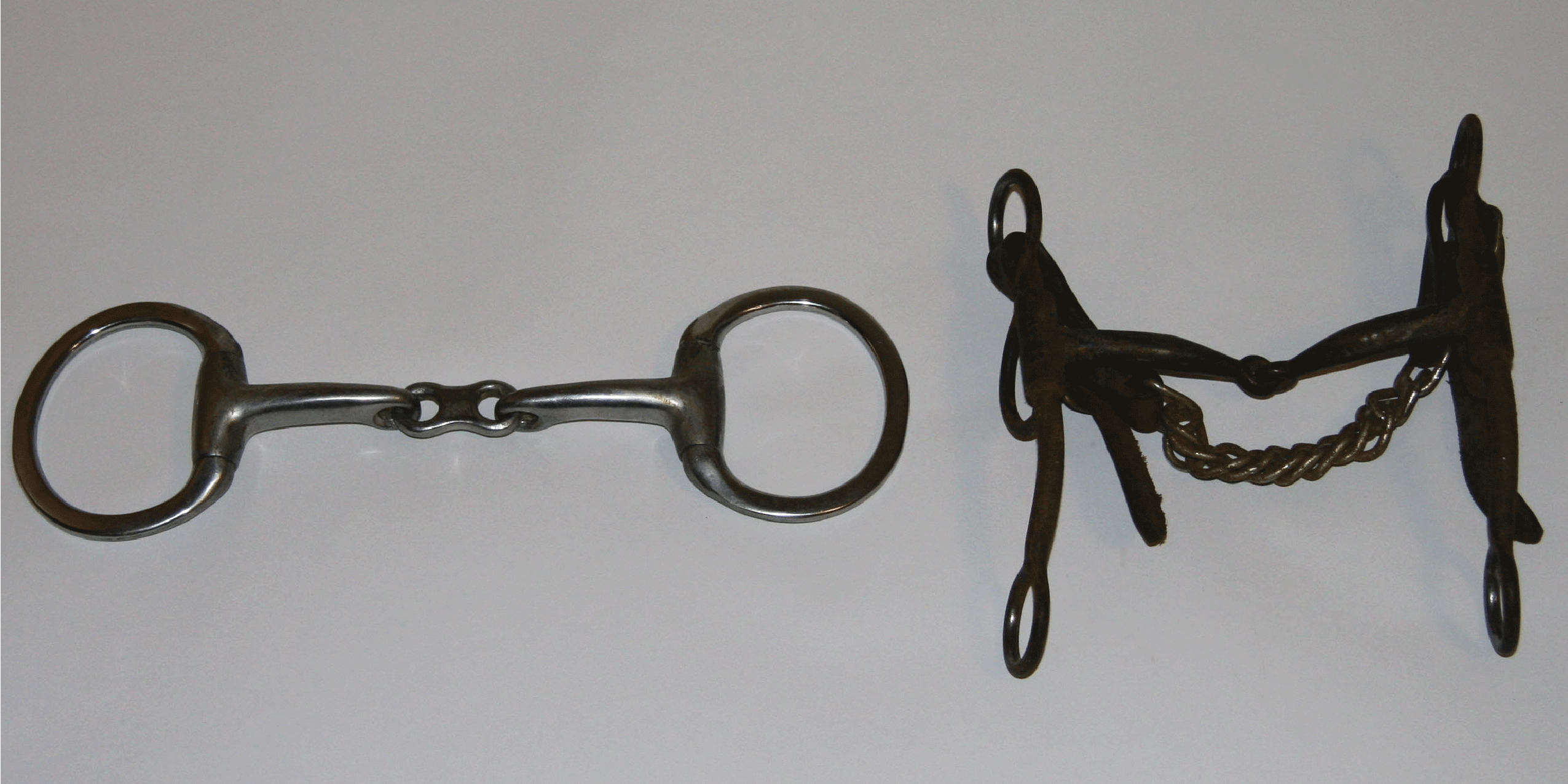 Figure 1. Examples of a commonly seen snaffle bit (left) and curb bit (right). Notice that on the snaffle bit, reins attach directly to the mouthpiece while on the curb bit, reins attach to a shank attached to the mouthpiece.
Figure 1. Examples of a commonly seen snaffle bit (left) and curb bit (right). Notice that on the snaffle bit, reins attach directly to the mouthpiece while on the curb bit, reins attach to a shank attached to the mouthpiece.The points on the horse's head that can be affected by a bit or some type of headgear include the tongue, bars, cheeks, lips, palate, nose, curb area and poll. Some pieces of headgear may be able to affect nearly all of these points while some may only affect two or three of these points. Snaffle bits are considered direct pull bits because when the rider pulls on the reins, that pressure is transmitted directly to the horse's mouth. It is a common misconception in the industry that a snaffle bit is one that has a broken mouthpiece; that is, the mouthpiece is comprised of at least two pieces. This is wrong, even though many catalogs, books and "experts" propagate it. A snaffle bit may have a solid mouthpiece, a two-piece mouthpiece, a three-piece mouthpiece or multiple links such as a chain. The mouthpiece may or may not have a port, rings, keys, dogbone, etc. The key to identifying a snaffle is that it is a bit that operates off of direct pull; there is no leverage involved. The reins on a snaffle bit attach directly to the mouthpiece, not to a shank. A curb bit, on the other hand, involves leverage, which means the reins are attached to a shank of some design. A curb strap of some type is used under the horse's chin. When the rider pulls back on the reins, pressure is applied not only to the horse's mouth and chin but also to the horse's poll; this is the leverage effect. It requires that the reins not attach directly to the mouthpiece, but instead to some type of shank on the bit. The reins attach to the bottom part of the shank and the cheek pieces of the bridle attach to the upper part of the shank. As the rider pulls back on the reins, the top part of the shank moves forward as far as the curb strap will allow. This creates the leverage. The tighter the curb strap, the less pressure applied to the poll. The looser the curb strap, the more pressure can be applied to the poll as the top of the shank can move farther forward. Even if a curb is not used, there is still leverage on the horse's poll due to the fact that the reins are not attached directly to the bit but instead to a shank that rotates forward when pressure is applied to the reins. Poll pressure can be a very effective tool in eliciting certain responses from the horse. Horses are naturally inclined to move away from poll pressure and therefore will often lower their heads and flex at the poll to escape this pressure. This is a desired response used to achieve greater performance in many disciplines. However, to perform correctly in a curb bit, the horse must have already learned how to be guided willingly and submit to bit pressure. Too much poll pressure too early in a horse's training will often cause the horse to either fight or evade the bit.
How to Select an Appropriate Bit
Size
When selecting a bit, the first consideration is to determine the appropriate or desired type of bit (snaffle or leverage). The next criterion should be to select the desired mouthpiece. Once the type of bit and mouthpiece are selected, the next consideration is to be sure that it is the proper width to fit the horse. Bit width is the distance between the two cheek pieces. Standard bits are 5 inches wide and are the most common. Pony bits are generally 4 1/2 inches wide, and bits that are designed for Arabians and other light-boned, refined horses are 4 3/4 inches wide. For horses with wider mouths, bits are available in widths of 5 1/2 inches, 6 inches and even wider for some draft horses. Bits wider than 5 inches may have to be special ordered, and the availability of styles and mouthpiece designs may be limited in commercial production bits. Sometimes it is necessary to have a bit custom built by a bit maker to achieve a desired style and size. The same is true to some degree with the narrow bits, although there is a wider selection in snaffle bits.
Material
Bits can be constructed of many types of materials. They are often composed of some type of metal, although bits made of other materials can also be found. Stainless steel is commonly used to manufacture bits today. This metal is a popular choice because it does not rust and, therefore, is appealing both for show purposes and everyday use. However, a rust-covered bit does not necessarily indicate decreased quality. Bit makers often use sweet iron when designing quality bits even though it rusts very easily and does not maintain a shiny appearance for long. However, is very palatable to horses and thus is often a popular choice among experienced horsemen. Sometimes bits are composed of a sweet iron mouthpiece with stainless steel cheek pieces. This allows the bit to maintain its new-looking appearance outside the horse's mouth while the part that is in the mouth is made of the more palatable metal.
Copper is often included in bit making because it causes the horse to salivate. While bits are not made entirely of copper, often the mouthpiece will be made of copper or will have some type of copper roller or inlay. For horses that tend to produce less saliva and have a drier mouth, this increase in saliva allows the bit to slide or rotate more easily. The amount of copper on a bit can range from very small inlays that rest against the horse's tongue to fairly large rollers.
Another metal that is sometimes seen in bit making is aluminum. The aluminum bit trend started many years ago and still exists today, primarily in lower quality bits. Aluminum is not a particularly desirable metal for bit construction due to its light weight and unpalatable taste. Also, because aluminum oxidizes readily these bits may break unexpectedly. The lightness of these bits causes them to move too much in the horse's mouth and can cause the horse to have a diminished response to rein cues. Quality aluminum bits generally have shanks of a higher grade aluminum alloy and a mouthpiece made of some other material.
Other materials that might be seen in bit construction include synthetics or plastic ("happy mouth" bits) and rubber. Both of these materials are designed to be "soft" bits and lessen the harshness of rein cues. These can be effective on some horses but should be used with care. Often these bits are too mild and teach horses to pull against pressure rather than yield to it if used routinely. This is particularly true of rubber bits, which are often also very large in diameter. This large diameter can be troublesome for horses since it is typically used on young horses whose mouths are not big enough to carry it comfortably. Additionally, the use of rubber often promotes the habit of chewing on the bit.
Types of Mouth Pieces
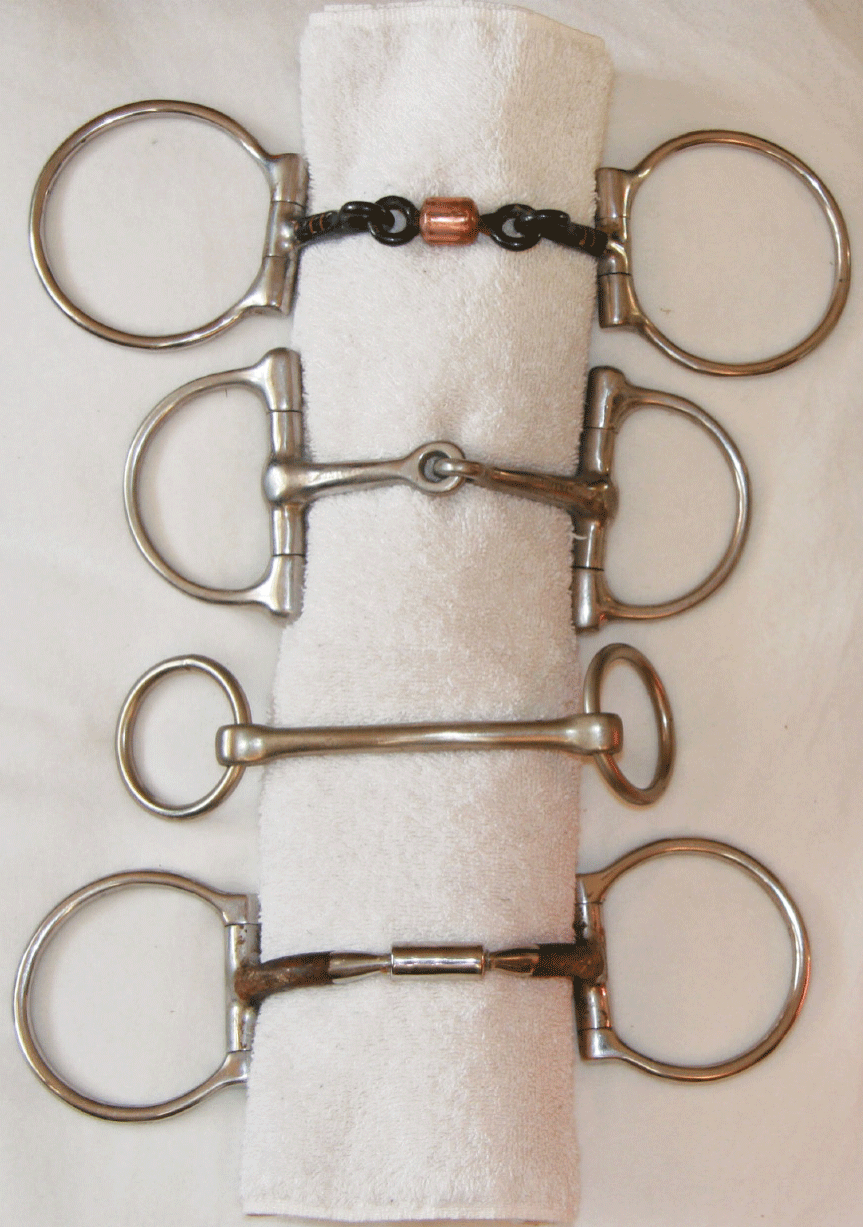 Figure 2. Examples of different snaffle bit mouthpieces. A bit that is broken in more than one location (top) shapes around the tongue, distributing pressure equally over the tongue and bars. A bit that is broken in one place (second from top) places pressure more on the bars of the mouth. A solid bit (second from bottom) places pressure more on the middle of the tongue. A barrel-hinged mouthpiece (bottom) has a limited range of motion.
Figure 2. Examples of different snaffle bit mouthpieces. A bit that is broken in more than one location (top) shapes around the tongue, distributing pressure equally over the tongue and bars. A bit that is broken in one place (second from top) places pressure more on the bars of the mouth. A solid bit (second from bottom) places pressure more on the middle of the tongue. A barrel-hinged mouthpiece (bottom) has a limited range of motion.After determining whether to use a snaffle or a curb and deciding on the appropriate width and material, the next step is to determine the style of mouthpiece needed. Selecting a mouthpiece is where much of the confusion surrounding bits begins. This is due in part to the vast number of mouthpieces available, and also to the lack of understanding of the conformation of the mouth and how the various mouthpieces fit and function in the mouth. It is possible to have a mouthpiece that is mild in its action and pressure (a soft bit) or severe (a harsh or hard bit). As previously stated, both a snaffle bit and curb bit may have either a broken or solid mouthpiece. How well a horse responds to a certain type of mouthpiece depends on each horse's mouth conformation and preference. The more broken (jointed) the mouthpiece is, the more it will conform to the horse's mouth. A mouthpiece that is broken in several places will conform around the tongue more than a mouthpiece that is solid or only broken in one place. A mouthpiece that is solid will place more pressure across and over the tongue while one that is broken in the middle will take some pressure off the center of the tongue when the reins are pulled, thereby placing pressure more on the bars of the mouth and the sides of the lips. A bit that is broken in multiple places will conform around the tongue and place pressure more equally over the tongue, bars and lips. Some horses with shallow palates are more comfortable with bits that conform around their mouth. Mouthpieces broken in only one place might come into contact with the horse's palate as the rider pulls back on the reins and the mouthpiece closes at the break. Each horse responds differently to different types of bit pressure; some horses respond better to bits that are solid while some respond better to bits that are broken. The rider must experiment to determine which bit a particular horse performs better in.
Snaffle Bits
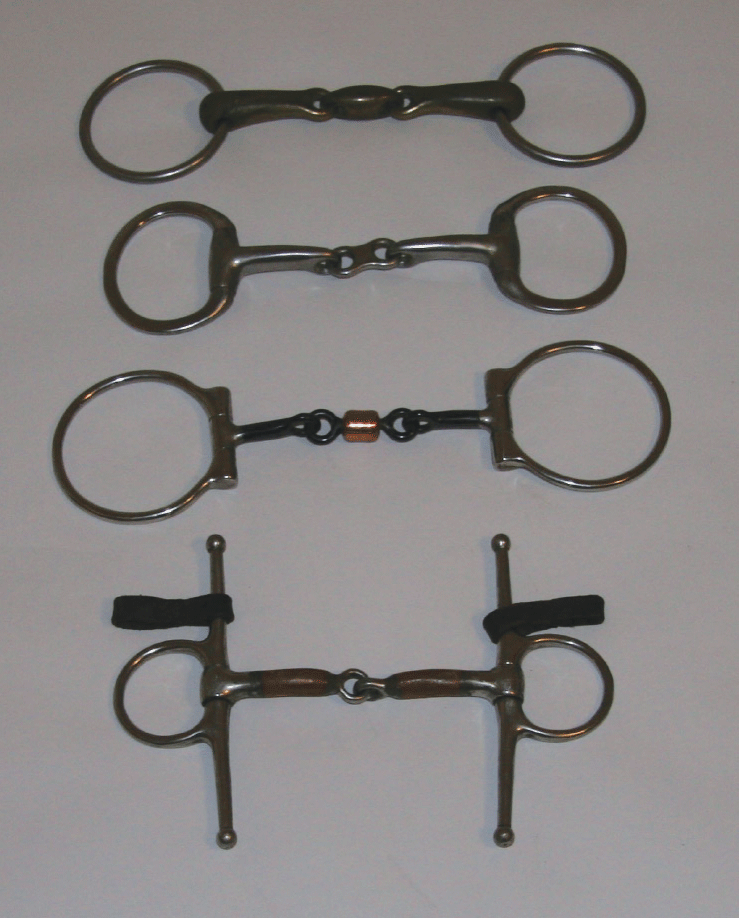 Figure 3. Snaffle bit styles: (from top to bottom) O-ring or loose ring, egg butt, D ring, full cheek with bit keepers.
Figure 3. Snaffle bit styles: (from top to bottom) O-ring or loose ring, egg butt, D ring, full cheek with bit keepers.When choosing a snaffle bit, the ring design must be considered. Snaffle bits typically are available in O-ring, D-ring, egg butt and full cheek configurations. The rings can vary in size from 2 1/2 inches in diameter to 4 inches, with 3 inches being fairly standard. O-ring and egg butt bits are probably the most popular styles. Full cheek bits are also popular, but should always be used with bit keepers for safety reasons; a full cheek bit that is not properly secured with a bit keeper can easily get snagged on surrounding items or injure nearby horses and riders. Full cheek bits and very large ringed bits are used in some training situations to apply pressure to the side of the horse's face when being asked to yield laterally, thereby encouraging the horse to yield better and also to prevent the bit from being pulled through the mouth.
Bit Severity
When using a snaffle bit, the main factors that affect severity are diameter and mouthpiece texture. A larger diameter mouthpiece results in the pressure applied to the tongue and bars being diffused over a larger surface area. This makes these bits less severe than a bit with a smaller diameter mouthpiece, which concentrates the pressure into a smaller area. Mouthpieces can be either smooth or textured.
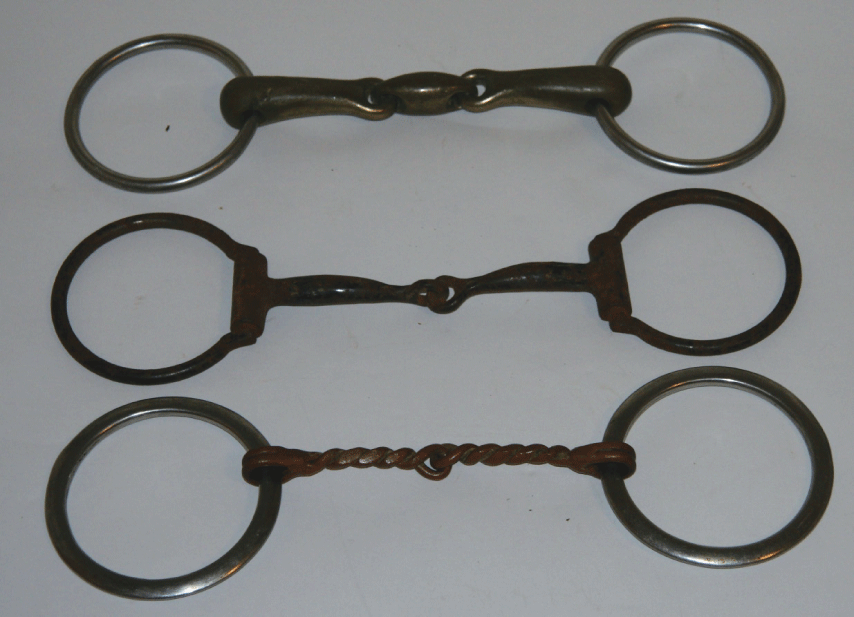 Figure 4. Examples of mouthpieces of different severity. From top to bottom: large diameter mouthpiece (least severe), mouthpiece with smaller diameter (moderate severity), mouthpiece with small diameter and twists (most severe).
Figure 4. Examples of mouthpieces of different severity. From top to bottom: large diameter mouthpiece (least severe), mouthpiece with smaller diameter (moderate severity), mouthpiece with small diameter and twists (most severe).A common texturing technique is to make a bit with twists in the mouthpiece, which can either be slow and rather smooth or fine and sharp. The thinner and sharper the twist, whether a corkscrew type or twisted wire, the more severe the mouthpiece since pressure will be concentrated in those areas. There are many gradations between the two extremes of soft and harsh bits, and a moderate bit is probably the best choice for most people and horses. Harsher bits should be reserved for people who know how and when to use them and have the patience and dexterity to use them properly. Soft bits can also be problematic because is easy to teach a horse to pull against and evade them. This is certainly not desirable, though many people make this mistake in trying to be kind to their horse. A second problem associated with soft bits is that they are generally large in diameter and many young horses may not have enough room in their mouth to comfortably carry them, as discussed earlier with rubber bits. This can lead to annoying habits such as excessive mouthing of the bit.
Curb Bits
Selecting a curb bit is similar to selecting a snaffle bit; however, in addition to selecting the type and size of the mouthpiece, it is important to determine the appropriate shank. The shank can be either a solid cheek or a shank that can swivel (swivel cheek). It is also critical to determine what length and shape of shank is desired. Shanks are available in several styles. They may be straight, have a gentle sweep (C-bit), an acute sweep (grazing bit) or a variety of patterns (S shank, 7 shank, cavalry shank). Shank length determines the bit's severity. The average shank length is 6 to 7 inches, but may vary from approximately 4 inches to 8-plus inches. It is important to understand certain principles about leverage bits. A straight shank, in comparison to a curved shank, is quicker acting. A longer shank produces more leverage than a shorter shank, but is slower acting. The ratio of the amount of shank above the mouthpiece to the amount of shank below the mouthpiece also helps to determine bit severity; the longer the shank is below the mouthpiece in comparison to the length of shank above the mouthpiece, the more leverage the bit will have. Bits that have broken mouthpieces and/or swivel cheeks are slower acting and provide the horse with what essentially amounts to a preparatory signal.
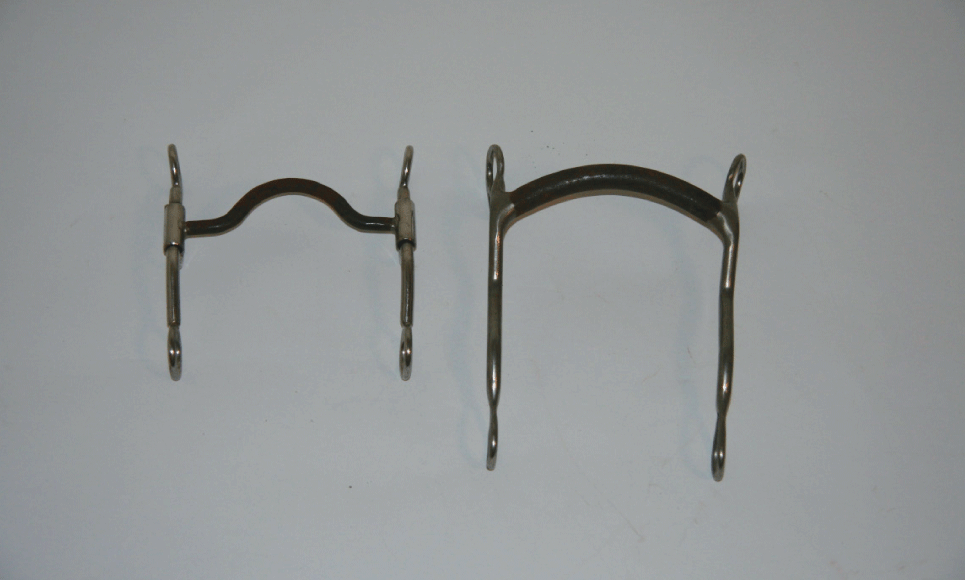 |
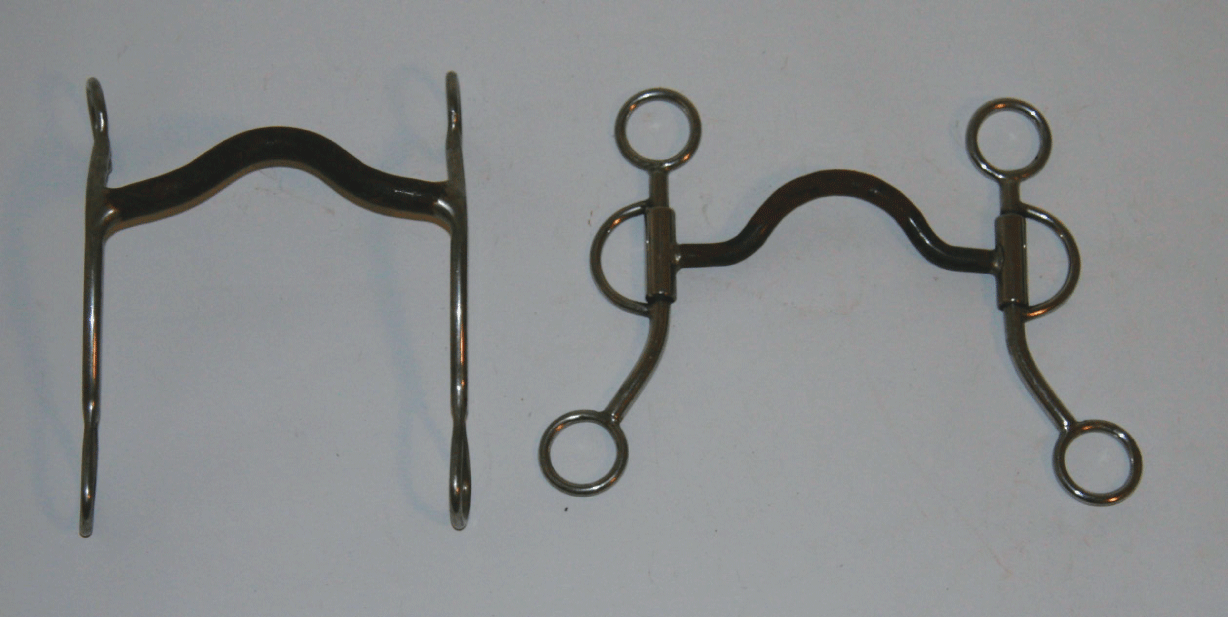 |
| Figure 5. Shank length helps determine bit severity. The bit on the right has a longer shank and therefore more leverage compared to the bit on the left. Additionally, the ratio of shank length below the mouthpiece compared to the length above (purchase length) for the bit on the right is greater, which increases the leverage factor. | Figure 6. The bit on the right has a shank that swivels; the bit on the left does not. |
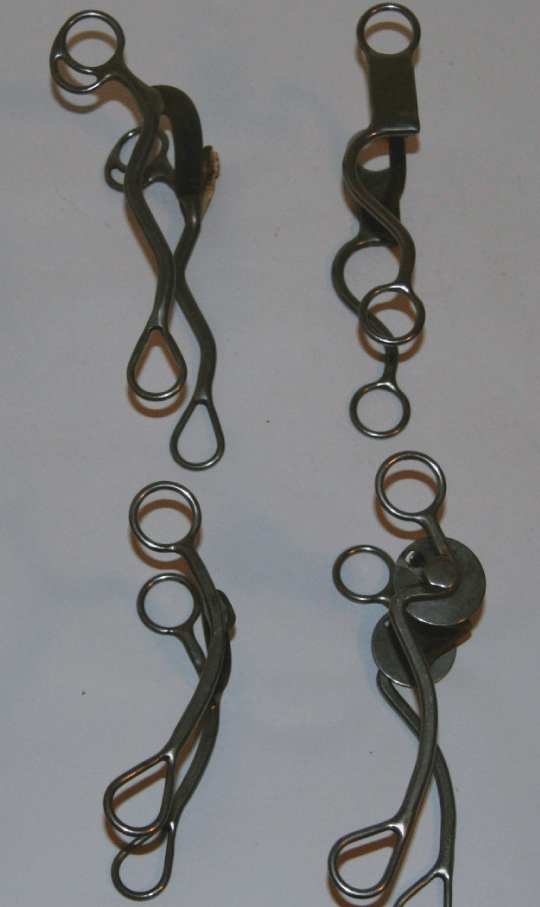 |
 |
| Figure 7. Different styles of shanks on curb bits. Note that the bottom right bit has shanks that rotate independently, but has a controlled range of motion due to a built-in stop. | Figure 8. Ports of varying shapes and sizes. The bottom center and right bits have ports high enough to come in contact with the horse’s palate. The upper right bit also has a port that could touch the palate because of the combination of port height and width, but it would produce almost no tongue pressure. |
Another aspect to consider when selecting curb bits is the port. A port is simply an area in the center of the mouthpiece that deviates from a straight line and, therefore, is raised off of the tongue as the bit is rotated by rein pressure. A port can be in the shape of a half square, a half-moon or a triangle. The port provides tongue relief because as the rider pulls back on the reins, the horse's tongue moves inside the port, thereby placing more pressure on the bars of the mouth and less on the tongue. Some horses may prefer this type of bit and respond well to it while others may not. A port does not come into contact with the roof of the horse's mouth until it reaches a certain size (ports greater than approximately 2 inches may come into contact with the roof of the mouth) and is dependent upon how tight the curb strap is adjusted. A high port is found in correction bits and cathedral bits and should only be used on highly trained horses and by riders who have the knowledge to use them effectively and correctly. The function of a high port is to bump the roof of the horse's mouth, causing the horse to respond by lowering its head and flexing at the poll with minimal pressure applied to the reins. This is a learned response and should only be used on "finished" horses that have already learned to yield readily to rein pressure.
Other Types of Bits
Although there are many different factors to consider when selecting a bit, it is important to understand that there are always exceptions and modifiers to most rules. Not every bit fits neatly into a category, especially when trying to classify everything as either a snaffle or traditional curb. In addition, it is not possible to classify bits as either English bits or Western bits. Kimberwick, pelham, gag and elevator bits should be considered combination bits, in that their action is not exactly that of a snaffle or true curb bit.
There is also a very large group of bits used primarily by the speed events and rodeo disciplines that cannot be neatly classified. Many of these bits use a modified gag action and many also function like a mechanical hackamore. Bits with a gag action typically allow the mouthpiece to slide upward on the cheek pieces or rings when the rider pulls on a rein. These are used in many disciples that require turning maneuvers since the rider can essentially pick up one side of the bit by pulling on that rein. These bits and mechanical hackamores continue to gain acceptance in the jumper ring as well as with many of the gaited horse communities.
Conclusion
Regardless of the bit selected, the rider's hands are the most important factor in communicating with the horse and influencing bit effectiveness and severity. Correct use of hands is critical in determining bit performance. In most instances, the problems perceived as resulting from not having the correct bit are in reality training problems. There are many instances when using the appropriate bit can enhance the training process. On the other hand, using an inappropriate bit may produce undesired responses such as resistance to pressure, head shaking, excessive mouthing of the bit, excessive reaction to the bit (such as rearing) or overflexing at the poll. It is important to find a bit that works well for both horse and rider based on the experience level of both. Inexperienced riders or horses should be equipped with softer, less severe bits. Inexperienced riders lack the hand control to use more severe bits effectively without damaging the horse's mouth. Inexperienced horses often have not learned the desired responses to bit cues and may be confused or overwhelmed by severe bits. It is important to experiment with bit selection to determine which bit works best for a particular horse and rider combination.
1 Kylee J. Duberstein, Ph.D., Department of Animal and Dairy Science, University of Georgia
2 Edward L. Johnson, Ph.D., Department of Animal Sciences, University of Florida
Status and Revision History
Published on Jan 20, 2011
Published on Feb 04, 2011
Published with Full Review on Jun 05, 2014
Published with Full Review on Feb 20, 2024


























































